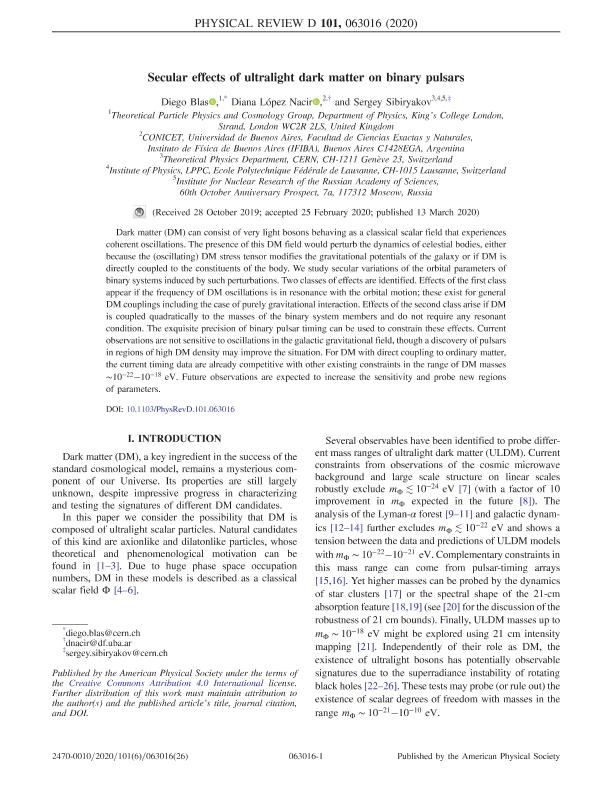Mostrar el registro sencillo del ítem
dc.contributor.author
Blas, Diego
dc.contributor.author
Lopez Nacir, Diana Laura

dc.contributor.author
Sibiryakov, Sergey
dc.date.available
2021-11-04T15:39:40Z
dc.date.issued
2020-03
dc.identifier.citation
Blas, Diego; Lopez Nacir, Diana Laura; Sibiryakov, Sergey; Secular effects of ultralight dark matter on binary pulsars; American Physical Society; Physical Review D: Particles, Fields, Gravitation and Cosmology; 101; 6; 3-2020; 1-26
dc.identifier.issn
1550-7998
dc.identifier.uri
http://hdl.handle.net/11336/146008
dc.description.abstract
Dark matter (DM) can consist of very light bosons behaving as a classical scalar field that experiences coherent oscillations. The presence of this DM field would perturb the dynamics of celestial bodies, either because the (oscillating) DM stress tensor modifies the gravitational potentials of the galaxy or if DM is directly coupled to the constituents of the body. We study secular variations of the orbital parameters of binary systems induced by such perturbations. Two classes of effects are identified. Effects of the first class appear if the frequency of DM oscillations is in resonance with the orbital motion; these exist for general DM couplings including the case of purely gravitational interaction. Effects of the second class arise if DM is coupled quadratically to the masses of the binary system members and do not require any resonant condition. The exquisite precision of binary pulsar timing can be used to constrain these effects. Current observations are not sensitive to oscillations in the galactic gravitational field, though a discovery of pulsars in regions of high DM density may improve the situation. For DM with direct coupling to ordinary matter, the current timing data are already competitive with other existing constraints in the range of DM masses ∼10-22-10-18 eV. Future observations are expected to increase the sensitivity and probe new regions of parameters.
dc.format
application/pdf
dc.language.iso
eng
dc.publisher
American Physical Society

dc.rights
info:eu-repo/semantics/openAccess
dc.rights.uri
https://creativecommons.org/licenses/by-nc-sa/2.5/ar/
dc.subject
DARK MATTER
dc.subject
FIELD THEORY
dc.subject
BINARY PULSARS
dc.subject
GRAVITY
dc.subject.classification
Física de Partículas y Campos

dc.subject.classification
Ciencias Físicas

dc.subject.classification
CIENCIAS NATURALES Y EXACTAS

dc.title
Secular effects of ultralight dark matter on binary pulsars
dc.type
info:eu-repo/semantics/article
dc.type
info:ar-repo/semantics/artículo
dc.type
info:eu-repo/semantics/publishedVersion
dc.date.updated
2021-09-07T18:30:37Z
dc.journal.volume
101
dc.journal.number
6
dc.journal.pagination
1-26
dc.journal.pais
Estados Unidos

dc.journal.ciudad
New York
dc.description.fil
Fil: Blas, Diego. King's College London; Reino Unido
dc.description.fil
Fil: Lopez Nacir, Diana Laura. Consejo Nacional de Investigaciones Científicas y Técnicas. Oficina de Coordinación Administrativa Ciudad Universitaria. Instituto de Física de Buenos Aires. Universidad de Buenos Aires. Facultad de Ciencias Exactas y Naturales. Instituto de Física de Buenos Aires; Argentina
dc.description.fil
Fil: Sibiryakov, Sergey. Cern - European Organization for Nuclear Research; Suiza
dc.journal.title
Physical Review D: Particles, Fields, Gravitation and Cosmology

dc.relation.alternativeid
info:eu-repo/semantics/altIdentifier/url/https://doi.org/10.1103/PhysRevD.101.063016
dc.relation.alternativeid
info:eu-repo/semantics/altIdentifier/doi/http://dx.doi.org/10.1103/PhysRevD.101.063016
Archivos asociados
